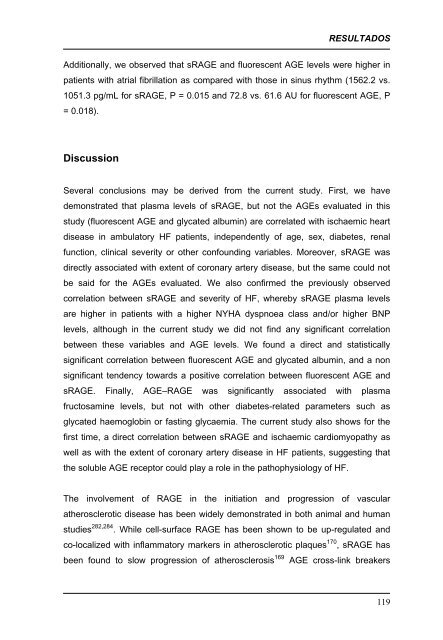INTRODUCCIÓN: REVISIÓN CRITICA DEL PROBLEMA
INTRODUCCIÓN: REVISIÓN CRITICA DEL PROBLEMA
INTRODUCCIÓN: REVISIÓN CRITICA DEL PROBLEMA
Create successful ePaper yourself
Turn your PDF publications into a flip-book with our unique Google optimized e-Paper software.
RESULTADOS<br />
Additionally, we observed that sRAGE and fluorescent AGE levels were higher in<br />
patients with atrial fibrillation as compared with those in sinus rhythm (1562.2 vs.<br />
1051.3 pg/mL for sRAGE, P = 0.015 and 72.8 vs. 61.6 AU for fluorescent AGE, P<br />
= 0.018).<br />
Discussion<br />
Several conclusions may be derived from the current study. First, we have<br />
demonstrated that plasma levels of sRAGE, but not the AGEs evaluated in this<br />
study (fluorescent AGE and glycated albumin) are correlated with ischaemic heart<br />
disease in ambulatory HF patients, independently of age, sex, diabetes, renal<br />
function, clinical severity or other confounding variables. Moreover, sRAGE was<br />
directly associated with extent of coronary artery disease, but the same could not<br />
be said for the AGEs evaluated. We also confirmed the previously observed<br />
correlation between sRAGE and severity of HF, whereby sRAGE plasma levels<br />
are higher in patients with a higher NYHA dyspnoea class and/or higher BNP<br />
levels, although in the current study we did not find any significant correlation<br />
between these variables and AGE levels. We found a direct and statistically<br />
significant correlation between fluorescent AGE and glycated albumin, and a non<br />
significant tendency towards a positive correlation between fluorescent AGE and<br />
sRAGE. Finally, AGE–RAGE was significantly associated with plasma<br />
fructosamine levels, but not with other diabetes-related parameters such as<br />
glycated haemoglobin or fasting glycaemia. The current study also shows for the<br />
first time, a direct correlation between sRAGE and ischaemic cardiomyopathy as<br />
well as with the extent of coronary artery disease in HF patients, suggesting that<br />
the soluble AGE receptor could play a role in the pathophysiology of HF.<br />
The involvement of RAGE in the initiation and progression of vascular<br />
atherosclerotic disease has been widely demonstrated in both animal and human<br />
studies 282,284 . While cell-surface RAGE has been shown to be up-regulated and<br />
co-localized with inflammatory markers in atherosclerotic plaques 170 , sRAGE has<br />
been found to slow progression of atherosclerosis 169 AGE cross-link breakers<br />
119
















